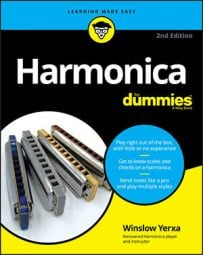Use your fingertips to pick up the harp by its ends. Doing this allows you to perform the essential task of getting the harmonica in your mouth. However, your hands perform two additional functions:
Finding the hole you want to play without looking: Why go cross-eyed peering down at the little numbers on the covers? If you always hold the harmonica the same way, the harp will always be in the same place relative to your hands and you’ll start memorizing the locations of the different holes on the harmonica and find them without looking around for the note you want to play.
Shaping and coloring your sound: While one hand holds the harp, the other can cover or expose the back and sides of the harmonica, changing the tone color between dark and bright, pulsing the sound with a wavering sound called vibrato, making notes louder or softer (quieter), and making vowel sounds that mimic human speech.
When you play into a microphone, your hands fulfill a third function: interacting with the microphone.
When you wrap both hands around the harmonica, you’re cupping the harp. The method you settle on becomes your grip, and harmonica players debate the fine points of a grip just like golfers debate holding and swinging a golf club.
In Chapter 3, Video Clip 0304, you can see the classic sandwich grip, which is versatile and probably the most widely used method of holding a harmonica. To form this grip, follow these steps:
Stand with your arms relaxed at your sides.
Bring your hands together at chest level and cup them together.
You should be able to hold water in the cup your hands have formed.
Bring your thumbs together.
You should be able to see where the harmonica goes — between your thumb and forefinger. Don’t pick up the harp yet, though; you have one more thing to do.
Make a slight opening in the back of your hands, just below your little fingers.
You can see the opening through the space between the thumb and forefinger of your left hand. This opening is the edge opening, which lets you focus the sound coming out.
![[Credit: Photograph by Anne Hamersky]](https://www.dummies.com/wp-content/uploads/455771.image0.jpg) Credit: Photograph by Anne Hamersky
Credit: Photograph by Anne Hamersky
Congratulations! You’ve formed a hand cup. This cup gives you a lot of power over the harp’s tone. But wait, there’s more! You still need to add the harmonica. Here’s how:
Pick up a harmonica and hold it between the thumb and forefinger of your left hand (remember, the name and hole numbers should be on top).
Don’t jam the left edge of the harp into the webbing between your thumb and forefinger. Let it poke out a little. Doing this helps prevent joint pain and deformity from pressure, and it also helps you cup the harp if you have small hands (or when you play a longer harp, such as a tremolo or a chromatic harp).
Place your fingers as close to the back edge of the covers as possible.
Leave enough room to get your lips on the covers and the harmonica into your mouth.
Don’t grab the harp will all your might. Relax your hand and hold the harp gently but firmly, just enough so that it doesn’t fly out of your hand while you play.
Wrap your right and left hands together so that your hand encloses the harp, and then make an edge opening below the little fingers.
The harmonica may feel like it’s coming alive in your hands, but it isn’t trying to wriggle away and escape into the water. So don’t try to crush it in a death grip. Hold it lightly, so that you can easily pull it away with your right hand.

